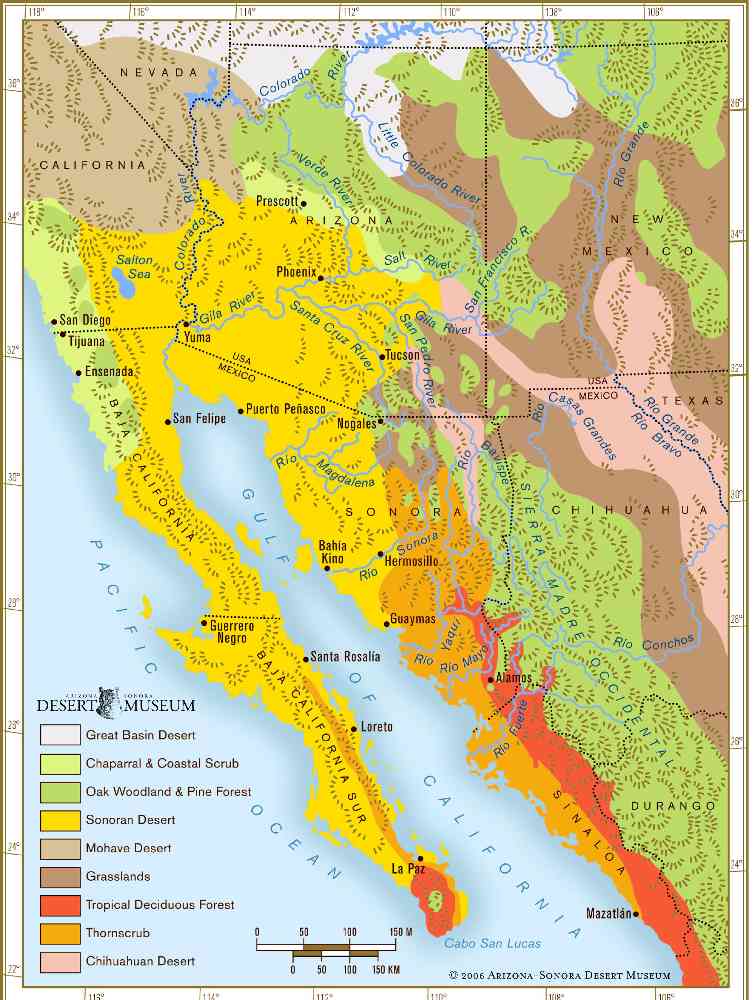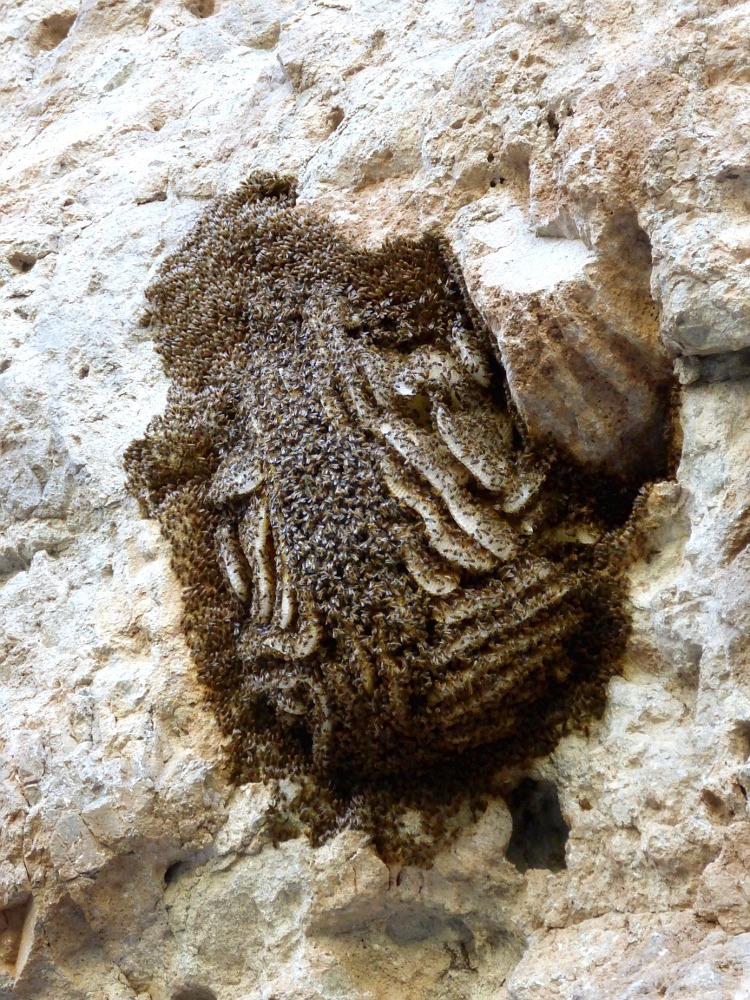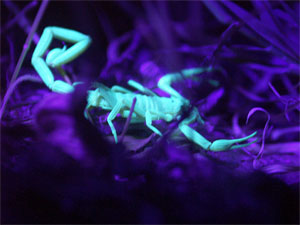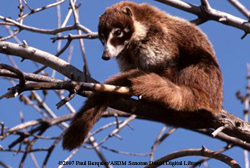 |
| Deserts of the North American Southwest |
To see the abundant wildlife you need to hike early or late as most animals siesta during the day.
Here is some need to know info on some prickly desert critters.
 |
| Giant Bee hive in rocks |
WHAT TO DO - Get away. If you notice lots of bees, on bushes, flowers, a crack in rocks, etc. go the other way. If one or more hits you (usually on head) get away from the area. You need to be 200 feet or more away before they seen to stop chase. If you are swarmed, you are going to be stung. You will need to try to minimize how much. Keep your mouth closed and move away quickly. Go under water ONLY if it is possible to swim a long distance away.
Once you’ve escaped the swarm, remove any stingers from your skin as soon as possible. Honey bees are one of the only stinging insects that leaves its stinger in the skin. Left in the skin, the accompanying venom sac will continue to pump venom. Pull the stingers out with a knife blade scraped gently across the skin, or by scraping off with your finger nails, credit card, etc. Seek medical attention immediately, especially if you experience hives, swelling around the throat or face, or difficulty breathing. While an average healthy adult may be able to withstand hundreds of bee stings, for people with bee venom allergies even a single sting can be highly dangerous.
SNAKES - #Rattlesnakes are a very real presence in the Sonoran Desert. They are seen often. They are often found under rocks or sunning themselves in open areas (across trails). The rattle sound when they are disturbed is distinct, even if you have never heard it. However, we are seeing more and more rattlers Not rattling before striking.

WHAT TO DO - Be cautious & back away. Most strikes seem to happen to men age 20 - 30, on the forearms, which screams, Don't Mess With Them! Be careful stepping over rocks and thru tall brush. Make a little noise with your feet as you walk. Kick some dirt, scuff yer feet along the ground. This will alert them and hopefully make them rattle.
 |
| See the Rattler? |
Pay attention to your dog if you hike with one. My dog used to stop and practically point right at them. If you're close to a rattler when you see it, back away slow and steady. If you must go in the direction it lies, throw rocks or sand at it to get it to move. If you are bit, STAY CALM, walk out and get medical attention. The worst effects are mostly on the very young, elderly or those in poor health. If you can not walk out; Remain calm and move beyond the snake's striking distance.
Remove jewelry and tight clothing before you start to swell.
Position yourself, if possible, so that the bite is at or below the level of your heart.
Clean the wound, but don't flush it with water. Cover it with a clean, dry dressing.
Don't use a tourniquet or apply ice.
Don't cut the wound or attempt to remove the venom.
Don't drink caffeine or alcohol, which could speed the rate at which your body absorbs venom.
Don't try to capture the snake.
Try to remember its color, pattern and shape so that you can describe it, which will help in your treatment.
Signal for help. Seek medical attention.
SIDE NOTE: Cowboy culture has an old wives tail about laying a rope in a circle around your sleeping bag or bedroll at night to prevent snakes from coming in. The idea is a snake wilk not cross a rope. There is no scientific evidence of this but... it can't hurt.
ANTS, SCORPIONS, SPIDERS & SUCH - We have some pretty nasty itsy bitsy critters in the Sonoran Desert. No doubt about it. But they are not difficult to avoid and do not cause too much havoc in the wild. Scorpions, for example, cause much more problems in populated areas. Fire ants, the big black ones, black widows and our #bark scorpions can all land you in a world if hurt. The bark #scorpion is also one of the very rare Scorpions that climbs, so it can be found in lots of places. That's where the old cowboy story comes from about shaking out your boots in the morning before putting them on. Sometimes they climb in yer shoes to get warm at night. The Bark scorpion is hard to see during the day but glows green under UV light and this is an effective way to find them at night.
 |
| Bark Scorpion under UV light |
WHAT TO DO - Watch out for them. We do not really stop and stand or sit without checking the ground, here in the desert. We turn over rocks or wood before picking them up (a scorpion may be clinging to the underside). Don't set up camp on top of holes in the ground. Those are where the critters come from.
Check sleeping bags, shoes, pants, jackets, etc before getting into them. Zip yer tent when not in it. Carry Sting ease spray. Scorpion stings and black widow bites are painful, sometimes very painful, but rarely life threatening. Seek medical attention. When it comes to Scorpions, Indy was right. The bigger the better. The big ones will often inject less venom into you, maybe conserving it. The little ones are the ones you have to worry about. They'll shoot their whole wad.
Side Note: I was stung in the back 3 times by a baby Bark Scorpion. It felt like Mike Tyson had used my back for a punching bag for almost 2 weeks.

 |
| Coati or Coatimundi |
 |
| Ringtail (not a cat) |
Rats and mice as well as #coatis, #raccoons, #ringtails, squirrels prairie dogs and chipmunks will all mess with yer food when it's left unattended and unprotected in camp. This is especially true in heavy use campsites.
WHAT TO DO - Protect your food.
Hanging food might help, but these little suckers can climb anything. Store food in a protective container like a cookie tin with a tight lid and/or an airtight sack. I do all 3, hang bag, tin & Locsak. In my experience, plastic containers like coolers don't cut it. I've seen some pretty heavy duty plastic chewed right through. If food is chewed on, it's best not to eat it as hantavirus is also transmitted by saliva and urine. For this reason it is important to check and filter or purify questionable water sources thoroughly, especially stagnant ones or where there are signs of rodents. Don't explore small dens because the #hantavirus is airborne.
Do not collect water from small puddles that have rodent tracks or droppings around them. Do not use kindling wood from pack rat nests
GILA MONSTERS - The Sonoran Desert has the only 2 venomous lizards in the world. The #gilamonster and Mexican beaded Lizard. Both are generally slow movers and if ya don't mess with um ya shouldn't have a problem. They have no fangs, instead they latch on with strong jaws and wriggle, grinding their sharp teeth into flesh and secreting their venon in their saliva, and really, who has the time or energy to go to all that trouble? They are protected by state law and should be left alone. Bites are dangerous, some Very violent reactions can occur to the neurotoxin venom.
What to do - Give way. If you are bit seek medical attention immediately. Shoo them away with long sticks or throwing sand and such.

The pic blow is only the 2nd Gila I've ever seen in the wild in almost 40 years of hiking here. We had lunch with him as he hung out, vertically, in between these rocks and we named him Edger.
 |
| Edger |
In Part 2, we'll look at some bigger critters.
Tread lightly.
Packman
www.raisedbyraccoons.blogspot.com

No comments:
Post a Comment